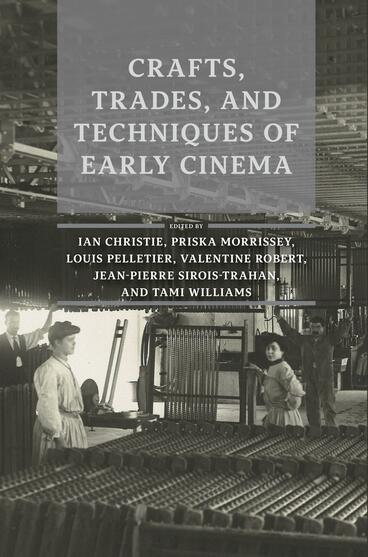Crafts, Trades, and Techniques of Early Cinema
Description
These proceedings of the 16th conference of the international society for the study of early cinema Domitor includes 26 studies and numerous rarely seen figures dealing with the often overlooked history of the crafts, trades and techniques of early cinema. By examining material culture and the institutionalization of practices into trades during the late 19th and early 20th centuries, this new investigation into the skills and the techniques that defined the cinema in its early decades aims to foster a better understanding of the medium in its varied industrial and professional aspects. The art and gestures of craftspersons—including performers, camera operators, editors, directors, designers, engineers, projectionists, programmers, and critics—, like those of the factory or laboratory workers, are considered for their emerging specificity, as well as in relation to existing cultural, material and technological forms. This book shows how the industrialization of cinema, the professionalization of workers, and the standardization of techniques led to the creation (or at times, subversion) of norms, and consequently legitimized certain skills, crafts and techniques at the expense of others.
The intermedial approaches deployed in this collection bring into focus the influence of multiple professional worlds and cultural practices on the nascent film medium, as well as the necessary adaptations and transformations required by the latter. This circulatory dynamic concerns people and practices, studied in a non-diffusionist approach taking into account transcultural interactions. Chapters examine the mechanisms of professionalization and identity-building as they relate to professions such as filmmaker or colorist, as well as to more unexpected occupations such as accountant, censor, or chemical engineer.
The notion of technique is broadly defined. Several of the volume’s chapters deal with cameras or special effects, as well as with new historical investigation into mysterious technical devices such as shutters, cue systems or working samples. Going beyond this preoccupation with materiality, the collected studies also approach technique as a human and cultural activity, and thus as a set of gestures, crafts, and expertise. The book more specifically opens up a reflection on the skills of screen performers and on the training that brought the institutionalization of body techniques and film acting. The book further illustrates to an unprecedented extent that the first film workers were frequently women.
Several chapters are dedicated to the unconventional careers of specific film workers, with particular attention being given to the diversity and complexity of professional trajectories. Indeed, this book demonstrates that the invention of cinema was deeply enmeshed with the rise of international networks, which resulted in the standardization of technical practices within corporate and national contexts being ultimately shaped by globalization.
IAN CHRISTIE is professor of Film and Media History at Birkbeck College, and a film historian, curator, and broadcaster. He has written and edited books on Powell and Pressburger, Russian cinema, Scorsese, and Gilliam. He is also a Fellow of the British Academy, director of the London Screen Study Collection, and a past president of Europa Cinemas. His recent publications include The Art of Film: John Box and Production Design (Columbia University Press, 2009), Audiences (Amsterdam University Press, 2012), Doctor Zhivago (Palgrave and McMillan, 2016), and chapters and articles on early film copyright, film in the museum, the representation of the ancient world in early cinema, trick films and special effects, stereoscopy, and space and place on screen.
PRISKA MORRISSEY is a lecturer in film studies at Rennes 2 University. As a historian of cinema trades and techniques, she has investigated the history of French cinematographers, which she covered in the book Les as de la manivelle : le métier d’opérateur de prise de vues cinématographiques en France (1895-1930) (AFRHC, 2021). She is currently researching silent-era negative stocks.
LOUIS PELLETIER is research professional and instructor at Université de Montréal. He has published on early and silent cinema, film exhibition, experimental film, amateur cinema, film preservation and film technology in Film History, 1895, The Canadian Journal of Film Studies, Found Footage and The Journal of Film Preservation. He was co-editor of Tales from the Vaults: Film Technology over the Years and across Continents (FIAF/Technès, 2023) and Le cinéma dans l’œil du collectionneur (Presses de l’Université de Montréal, 2023).
VALENTINE ROBERT is Senior Lecturer at the University of Lausanne. A historian of both art and film, her research is fundamentally interdisciplinary, focusing on the relationship of cinema to painting, theater, magic lantern and tableaux vivants. Co-editor of Le film sur l’art (PUR, 2015) and Corporeality in Early Cinema (IUP, 2018), she was part of a SNF research project focusing on the representation of Christ, contributed to exhibitions at the Musée d’Orsay, National Gallery of Canada, Fine Arts Museums of San Francisco, and curated film programs for international film archives.
Professor JEAN-PIERRE SIROIS-TRAHAN is the director of the Cinéma and digital culture program of the Département de littérature, théâtre et cinéma at Université Laval. He has co-edited many publications, including a special issue (Fall 2003) of Cinémas dedicated to cinematic “dispositifs,” and an issue of Revue d’études proustiennes on Marcel Proust in the days of early cinema. Recently, he edited the film chronicles written by seminal Quebec journalist and politician René Lévesque (Lumières vives, Boréal, 2023). A film theorist and historian, he is currently working on the concept of decoupage, on the history of film criticism, and on early cinema.
TAMI WILLIAMS is Associate Professor of English and Film Studies at the University of Wisconsin-Milwaukee, and served two terms as President of Domitor, the International Society for the Study of Early Cinema (2016-2024). She is the author, editor, and/or co-editor of several books, most recently, Provenance and Early Cinema (2021), Germaine Dulac: What Is Cinema? (2019, 2020 CNC Prix du livre), Global Cinema Networks (2018), Performing New Media, 1895-1915 (2014), and Germaine Dulac: A Cinema of Sensations (2014), as well as a special issue of The Moving Image on “Early Cinema and the Archives” (2016). She also serves as a board member of Women Film History International.

